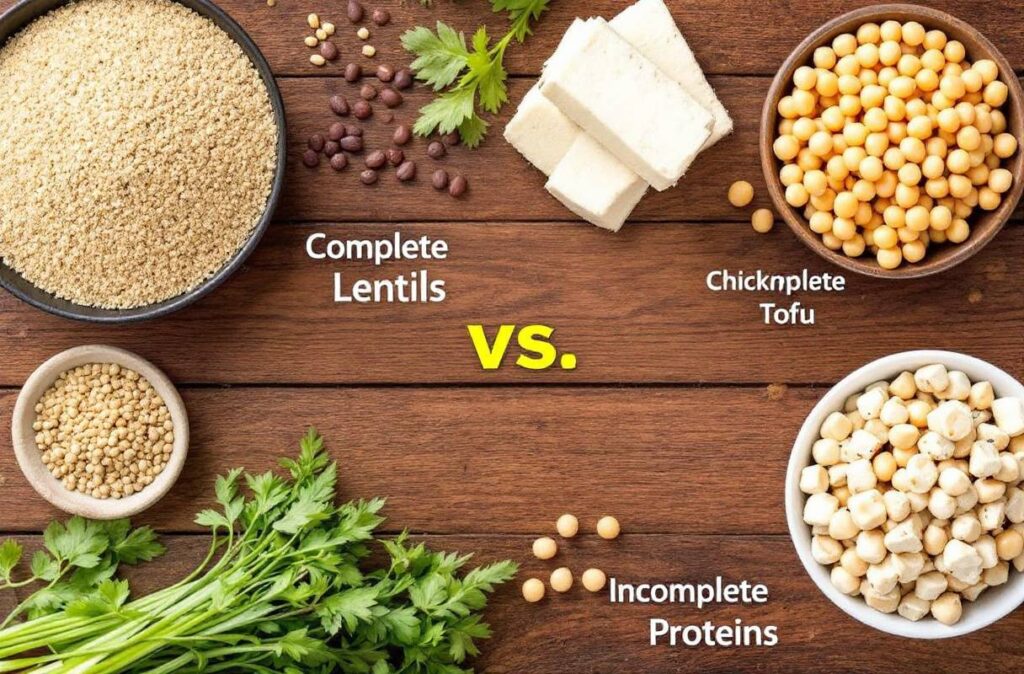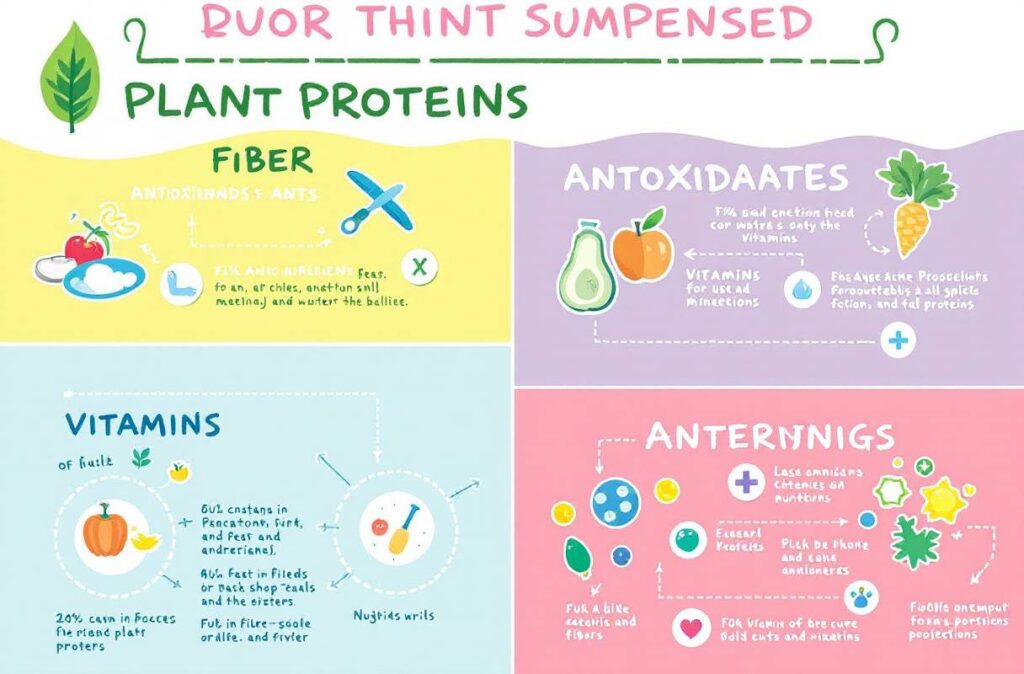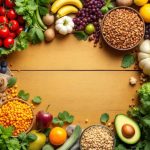Imagine transforming every meal into a powerhouse of nutrition while savoring delicious flavors and contributing to a healthier planet. Welcome to the vibrant world of plant-based proteins!
Whether you’re a seasoned vegan or just curious about incorporating more greens into your diet, understanding and utilizing the best plant-based proteins can supercharge your meals and elevate your well-being.
Let’s dive into the top plant-powered options that will keep your taste buds happy and your body thriving.
Understanding Plant-Based Proteins

When checking out plant-based eating, getting a handle on plant proteins is where it’s at. You’ve got complete and incomplete types, and knowing which is which helps ya keep your diet rock solid.
Complete vs. Incomplete Proteins
Complete proteins pack all nine amino acids your body can’t whip up by itself. Normally, animal stuff is what you’d call complete proteins, but hey, a few plants join the party too. Yup, soybeans, quinoa, buckwheat, chia seeds, hemp seeds, Ezekiel bread, spirulina, and nutritional yeast all make the cut (Healthline).
Incomplete proteins are missing a few amino acids. Most plants are in this boat, like beans, nuts, legumes, wheat, and wild rice. But don’t stress, mixing these bad boys together can give you the full amino deal. It’s called protein pairing, like beans with rice or hummus with whole wheat pita. Here’s a quick look:
| Protein Source | Complete/Incomplete |
|---|---|
| Quinoa | Complete |
| Buckwheat | Complete |
| Soybeans | Complete |
| Chia Seeds | Complete |
| Hemp Seeds | Complete |
| Beans | Incomplete |
| Nuts | Incomplete |
| Legumes | Incomplete |
| Wheat | Incomplete |
Essential Amino Acids in Plant Proteins
Amino acids are crucial players in keeping your body doing its thing like building proteins, fixing up tissues, and sucking up nutrients. Those nine must-have amino acids include histidine, isoleucine, leucine, lysine, methionine, phenylalanine, threonine, tryptophan, and valine.
There are some plant goodies that lock down all the crucial amino acids, giving you the full show. Key complete plant protein champs are:
- Quinoa: This little grain can play many parts—toss it into salads, bowls, or use as a side.
- Spirulina: A protein-packed algae in powders or tablets.
- Hemp Seeds: Sprinkle these on just about anything—smoothies, salads, yogurt.
- Nutritional Yeast: Provides a cheesy zing that’s perfect for vegan action.
- Ezekiel Bread: A bread made with sprouted grains, ideal for sandwiches or toast ops.
If you’re curious about hitting your daily protein goals or want a hand planning plant-based meals, go ahead and peek at our guides on meeting protein needs daily and planning plant-based meals.
Plus, plant-based diets bring bonus goodies like fiber, antioxidants, vitamins, and minerals, all fighters for overall health. Dig into more about plant-based proteins and their perks in articles on plant based diet for beginners, plant based diet weight loss, and how they help our planet stay green.
Benefits of Plant-Based Diets
Health Benefits of Plant Proteins
Plant-based diets serve up a smorgasbord of goodies for your health, which isn’t surprising given how positively folks respond to cutting back on meat. One notable perk is that plant eaters tend to have lower blood pressure than their meat-loving counterparts.
Those who go vegetarian often find themselves lighter on the scale, with lower cholesterol and a slimmed-down chance of getting hit by strokes, cancer, and heart disease. That right there could be a ticket to a healthier life!
Let’s break it down:
- Weight Management: Plants pack a punch in weight control thanks to all that fiber. It keeps you feeling full longer, so you don’t raid the fridge as much.
- Reduced Risk of Type 2 Diabetes: With plant proteins on the menu, your risk of type 2 diabetes takes a nosedive. Anti-inflammatory goodies in these foods help keep your blood sugar in check.
- Longevity: Want to stick around longer? Vegetables, nuts, and grains are packed with vitamins, minerals, and antioxidants that’ll boost your overall health.
Now, before you pile your cart with plant-based goodies, remember: not all veggie burgers and faux cheeses are your friends. Some of them can pack in the sodium and saturated fats, counteracting those hard-earned health benefits.
Environmental Impact of Plant Proteins
Eating greens isn’t just about what’s on your plate—it’s about the planet, too! Opting for plants over animals does wonders for our Earth, shrinking greenhouse gases and saving water like nobody’s business.
Consider these earth-loving perks:
- Greenhouse Gas Emissions: Say goodbye to meat and watch your carbon footprint shrink by half, or go veggie to cut it by a solid 35%.
- Water Efficiency: Growing plants doesn’t gulp nearly as much water as raising livestock, helping conserve one of our most precious resources.
- Lower Environmental Footprint: Making plant proteins spews way less greenhouse gas than churning out animal proteins, which makes a huge difference in our global impact (Kendall Reagan Nutrition Center).
Incorporating plants into your meals doesn’t just do wonders for the environment—it packs protection against chronic diseases, too. Plants hook you up with non-heme iron, which dodges the health risks linked to the heme iron found in meats like heart disease and diabetes (Down to Earth).
Curious to leap into this green world? Check out our guides on how to start a plant-based diet or plant based diet for beginners. Fill your plate with plant proteins, and you’ll not only fuel your health but also join the fight for a healthier planet!
Best Plant-Based Protein Sources
If you’re ditching the meat and diving into a plant-based lifestyle, you’re gonna need to get your hands on some kickin’ protein sources. Let’s meet the all-stars of plant protein: tofu, tempeh, edamame, lentils, chickpeas, peanuts, and chia seeds.
Tofu, Tempeh, and Edamame
First up, we’ve got the soy squad: tofu, tempeh, and edamame. These little protein powerhouses pack a punch with their variety of flavors and textures, perfect for jazzing up any dish.
- Tofu: Think of it as the blank canvas of your culinary dreams. Made from condensed soy milk pressed into blocks, tofu brings 10 grams of protein to your plate per ½ cup.
- Tempeh: This one’s got personality with its nutty taste and firm feel, offering a solid 15 grams of protein per ½ cup.
- Edamame: These vibrant young soybeans, often enjoyed right out of the pod, deliver 8.5 grams of protein per ½ cup — tasty and strong!
| Soy Product | Protein (g) per ½ cup |
|---|---|
| Tofu | 10 |
| Tempeh | 15 |
| Edamame | 8.5 |
Lentils and Chickpeas
Hopping over to our legume legends: lentils and chickpeas. These guys are not just about the protein; they’re packed with flavor and health perks!
- Lentils: These little gems are mighty, offering 8.84 grams of protein per ½ cup when cooked. They’re loaded with fiber, iron, and potassium, making ‘em a great addition to stews or salads to up your protein game (Medical News Today).
- Chickpeas: A culinary staple that brings 7.25 grams of protein per ½ cup your way. Toss them into stews, curries, or salads, or blend ‘em up into hummus for a tasty treat.
| Legume | Protein (g) per ½ cup |
|---|---|
| Lentils | 8.84 |
| Chickpeas | 7.25 |
Peanuts and Chia Seeds
And let’s not forget about those nutty treasures: peanuts and chia seeds. They’re small, but they rock some serious protein credentials.
- Peanuts: Bringing a hefty 20.5 grams of protein per ½ cup, they’re also great for heart health. Need a quick fix? Peanut butter, with 3.6 grams per tablespoon, is your go-to snack buddy.
- Chia Seeds: Don’t be fooled by their tiny size. These seeds pack 4.7 grams of protein per ounce, along with a dose of fiber and omega-3 magic.
| Seed/Nut | Protein (g) per ½ cup or ounce |
|---|---|
| Peanuts | 20.5 (per ½ cup) |
| Chia Seeds | 4.7 (per ounce) |
Working these protein heroes into your meals helps keep your health on track while also making your taste buds happy. For those looking to shake things up, explore more electrifying plant-based snack ideas or dig into our plant protein variety.
Nutritional Benefits of Plant Proteins

Who says veggies are just a side dish? Plant-based proteins are here to take center stage with all their goodness, like a superstar at a health food concert. Not only do they give your tummy a happiness boost, but they also give Mother Earth a big ol’ hug too. Check out the perks of diving into plant proteins, with a sprinkle of fiber, antioxidants, vitamins, and minerals.
Fiber and Antioxidants
When you’re munchin’ on plant proteins, you’re getting the prime benefit of fiber. Think of fiber as your gut’s best friend—it keeps things moving smoothly, helping out with digestion and making sure your blood sugar doesn’t act like a kid on a sugar rush. Plus, fiber’s the silent hero in your weight loss journey since it helps you feel full and satisfied (more info on plant-based diet weight loss).
Plants are also packing some serious antioxidant muscle. Ever heard of flavonoids, carotenoids, and polyphenols? Sounds fancy, right? They’re the bodyguards, standing firm against stress and inflammation, reducing the chances you’ll meet those unwanted guests like heart disease or diabetes.
| Nutrient | Main Benefits |
|---|---|
| Fiber | Helps digestion, fills you up, keeps your blood sugar steady |
| Antioxidants | Pushes back stress, lowers inflammation, defends against sour-stomach |
New to this green scene? Check out our guide on plant-based diet for beginners.
Vitamins and Minerals in Plant Foods
Plant proteins have got the goods when it comes to vitamins and minerals—they’re like Mother Nature’s multi-vitamins with extras on top. Important players in your plant menu include:
- Vitamin C: Keeps your immune squad at the ready and helps build your body’s legos (aka collagen).
- Vitamin E: Shields your cells.
- Folate: Your DNA’s trusty sidekick, fixing and building.
- Iron: The oxygen shuttle bus driver in your blood. For big hitters, see plant-based iron sources.
- Calcium: Toughens up your bones. Dig more on plant-based calcium foods.
- Magnesium: Keeps muscles and nerves tuned in, keeps your blood sugar in line, and helps make proteins.
| Vitamin/Mineral | Main Benefits |
|---|---|
| Vitamin C | Immune booster, helps build things like collagen |
| Vitamin E | Cell protector |
| Folate | DNA helper |
| Iron | Oxygen bus in your blood (see plant based iron sources) |
| Calcium | Builds stronger bones (check plant based calcium foods) |
| Magnesium | Keeps muscles moving and steady, checks blood sugar |
Eating a mix of plant proteins like beans, nuts, grains, and soy means you’re covering all the bases for essential nutrients. Take a peek at our plant based meal prep article to spice up your meals.
With all this plant power – antioxidants, fibers, vitamins, and minerals, you’re practically eating health on a plate! Trying out different plant proteins makes your diet look as colorful and varied as a rainbow! For more tips and tricks on including plant proteins in your meals, swing by our piece on how to start a plant-based diet.
Incorporating Plant Proteins
Meeting Protein Needs Daily
Getting your protein on a plant-based diet is not just a walk in the park—it’s also super rewarding. You’ll find yourself munching on foods that leave you fuller for longer, pack your digestive system with goodies, and brimming with antioxidants and other snazzy nutrients—a dream for your overall health.
Think you can’t get all your protein from plants? Think again! With a mix of legumes, nuts, and soy stuff, you’re all set. Beans carry this magical thing called fiber, giving your tummy a little TLC. Tofu? Smooth as a jazz tune and super easy on the allergen front . And nuts—they’re basically the fun snacks that keep your mouth entertained.
| Food Source | Protein (g) per Cup |
|---|---|
| Lentils | 18 |
| Chickpeas | 15 |
| Tofu | 20 (per 8 oz) |
| Almonds | 30 |
| Quinoa | 8 |
Mix these guys into your meals and snacks, and you’ll hit those protein targets like a pro. Whole grains like quinoa and veggies such as spinach and peas jump on the protein train too.
If ya need more deets, check out our handy article on plant based diet for beginners.
Planning Plant-Based Meals
Creating tasty, balanced plant-based meals is about mixing up your proteins—variety is the spice of life, right? With legumes, grains, nuts, and seeds, you can whip up some seriously good eats.
Sample Meal Plan Including Plant Proteins:
| Meal | Protein-Rich Foods |
|---|---|
| Breakfast | Smoothie with spinach, chia seeds, and almond milk |
| Lunch | Quinoa bowl with black beans, avocado, and mixed greens |
| Snack | Hummus with veggies or a handful of almonds |
| Dinner | Stir-fried tofu with broccoli and brown rice |
| Dessert/Additional Snack | Nut butter on whole-grain toast |
You’ll keep your taste buds happy and your body fueled with different textures and flavors. Get ahead by prepping meals in advance with cool tools like plant based meal prep, so chaos doesn’t rule your kitchen.
If you’re a gym rat, sports fan, or just dealing with particular health quirks, eating plant-based can really ramp up your game. For athletes, it’s all about muscle power and bouncing back stronger (plant based athlete diet). Need some kitchen inspo? Look at best plant based cookbooks for some ah-mazing meal ideas.
So by adding plant-based proteins and organizing your meals, you’ll crush your nutritional goals, keep healthy, and savor some tasty dishes. Worried about breaking the bank? Our guide on a cheap plant based diet has you covered so you can eat like a queen or king without draining your wallet.
Diverse Sources of Plant Protein
Checking out where all that plant protein hides can add a punch to your meals while keeping them tasty. Here are some of the best bets for loading up on plant-based proteins.
Beans, Nuts, and Legumes
Beans, nuts, and legumes are like those hidden gems in your diet, packed full of benefits that’ll keep you going strong.
Beans and Legumes
These are the MVPs when it comes to versatility and nutrition. Alongside protein, they’re bringing dietary fiber, vitamins, and minerals to the table. Stirring up a storm with beans and legumes can spice up your diet with essential stuff.
| Bean/Legume | Protein (g) per cup (cooked) |
|---|---|
| Lentils | 18 |
| Chickpeas | 15 |
| Black Beans | 15 |
| Kidney Beans | 13 |
Nuts
Nuts like almonds, walnuts, and peanuts pack a protein punch too! Plus, they’re loaded with those good-for-you fats and more.
| Nut | Protein (g) per ½ cup |
|---|---|
| Peanuts | 20.5 |
| Almonds | 16 |
| Walnuts | 9 |
Find some nutty inspiration in our plant-based snack ideas.
Grains, Seeds, and Soy
Grains, seeds, and soy are also doing their thing, helping you hit those protein goals without skimping on flavor.
Grains
Grains like quinoa and wild rice don’t just pack protein; they’ve got all those must-have amino acids too.
| Grain | Protein (g) per cup (cooked) |
|---|---|
| Quinoa | 8 |
| Millet | 6 |
| Wild Rice | 6.5 |
These grains can slip right into your meals, adding a nutritious boost.
Seeds
These little guys are powerhouses. Chia and hemp seeds especially go above and beyond in the protein department.
| Seed | Protein (g) per 2 tablespoons |
|---|---|
| Chia Seeds | 4.7 |
| Hemp Seeds | 6 |
| Flaxseeds | 3 |
Explore more about plant goodness in our guide on plant-based omega 3 sources.
Soy
Soy goodies like tofu, tempeh, and edamame are right at the top when it comes to plant-based protein. They’re versatile enough to fit in nearly any dish you dream up.
| Soy Product | Protein (g) per cup (cooked) |
|---|---|
| Tofu | 10 |
| Tempeh | 31 |
| Edamame | 17 |
Mixing in these plant proteins can really help cover your daily needs. For even more meal ideas, head over to our plant-based meal prep guide.
Complete Plant Proteins
Eating complete plant proteins means you’re getting all those essential amino acids your body craves to keep you fit and fab. Here’s a quick glance at some top-notch plant-based options that’s got you covered.
Quinoa, Spirulina, and Hemp Seeds
Quinoa
Quinoa’s not just any grain, it’s like the MVP of the whole protein block party. A cup packs 8 grams of protein, giving athletes and health buffs something to cheer about. Plus, with fiber, magnesium, and iron in the mix, quinoa just steps up your meal game.
| Nutrient | Amount per 1 cup (cooked) |
|---|---|
| Protein | 8g |
| Fiber | 5g |
| Magnesium | 118mg |
| Iron | 2.8mg |
Spirulina
Spirulina’s like the superhero of algae, flexing with 4 grams of protein per tablespoon. It brings a blend of antioxidants, vitamins, and minerals to whatever you’re munching on. Toss it in a smoothie or sprinkle on a salad, no cape needed.
| Nutrient | Amount per 1 tablespoon |
|---|---|
| Protein | 4g |
| Antioxidants | High |
| Vitamins | B1, B2, B3 |
| Minerals | Iron, Magnesium |
Hemp Seeds
These tiny gems aren’t just about protein. With a hefty dose of omega-3 and omega-6 fatty acids, they’re all about heart health. Toss 3 tablespoons in your smoothie or baking, and you’re looking at roughly 10 grams of protein goodness.
| Nutrient | Amount per 3 tablespoons |
|---|---|
| Protein | 10g |
| Omega-3 | 1000mg |
| Omega-6 | 2700mg |
Nutritional Yeast and Ezekiel Bread
Nutritional Yeast
Think cheesy flavor without the cheese. Nutritional yeast is the go-to for plant-based foodies. Just two tablespoons gives you 8 grams of protein and a blast of B vitamins. Sprinkle it on popcorn or pasta, and watch it transform your dish.
| Nutrient | Amount per 2 tablespoons |
|---|---|
| Protein | 8g |
| B Vitamins | High |
| Antioxidants | High |
Ezekiel Bread
Ezekiel bread shakes up the ordinary with sprouted grains and legumes. Each slice’s got about 4 grams of complete protein, plus a fiber and vitamin boost. Perfect for sandwiches or just as is, this bread’s in a league of its own.
| Nutrient | Amount per 1 slice |
|---|---|
| Protein | 4g |
| Fiber | 3g |
| Vitamins | B1, B2, B3 |
| Minerals | Iron, Magnesium |
For more tasty tips on getting complete proteins in your plant-based diet, check out our guides on plant-based diets and meal prep. You’ll be a plant-power pro in no time, soaking in all the good stuff like iron and calcium to balance out your menu.
Plant-Based Protein in Everyday Diets
Ditch your old go-to proteins like they’re last year’s fashion and explore the versatile world of plant-based options. Perfect for health nuts, tree huggers, and those gym rats looking to spice things up a bit. We’ll dig into some protein-packed plant subs and show you how to stay powered up with plants.
Protein-Rich Plant Substitutes
Keeping your meals interesting is the secret sauce to getting enough plant protein. Here’s a few top picks:
Seitan
No, this isn’t a spooky ritual—it’s a protein powerhouse with about 25 grams of protein per 3.5 ounces. Packed with selenium and bits of iron, calcium, and phosphorus too. Just watch out; it’s loaded with gluten, so it breaks up with anyone gluten-intolerant or sensitive.
Nutritional Yeast
Little flakes of goodness bringing 8 grams of protein per half ounce to the table. Chock full of fiber, zinc, magnesium, copper, manganese, and all the B vitamins for days, including that elusive B12.
Quinoa and Buckwheat
Make no mistake—these grains are in it to win it, serving up all nine essential amino acids. They’re great in salads, bowls, or playing the sidekick role at dinner.
| Plant Protein Source | Protein Content (per 100g) |
|---|---|
| Seitan | 25g |
| Nutritional Yeast | 8g (per 0.5 oz) |
| Quinoa | 14g |
| Buckwheat | 13g |
Snack time’s calling! Find more ideas on plant-based snack ideas.
Meeting Protein Requirements
Hitting your daily protein goals on this plant journey means mixing it up with different foods. Each one brings something unique to the amino acid party.
Combining Foods
Like that perfect buddy movie duo, combining beans and rice or hummus and bread gives you all nine essential amino wonders.
Daily Protein Intake
Drop plant proteins into each meal and snack. Think lentils, chickpeas, tofu, tempeh, nuts, seeds—take your pick.
| Meal | Protein Source |
|---|---|
| Breakfast | Smoothie with chia seeds (easy plant-based breakfast) |
| Mid-Morning Snack | Handful of almonds |
| Lunch | Quinoa salad with black beans |
| Afternoon Snack | Hummus and veggie sticks |
| Dinner | Stir-fry with tofu and broccoli |
Mixing up plant proteins keeps the nutrition balanced and your protein levels up. For more meal tips, check out plant-based meal prep.
Keep the variety alive, follow these hacks, and you’ll sneak plant-based goodness into your daily eats with ease. Hungry for more? Dive into fun plant-based cookbooks for recipes that’ll make your taste buds dance. Curious on how to get started? Here’s the lowdown on beginning your plant-based adventure.
Conclusion
Embracing plant-based proteins is not just a trend—it’s a transformative lifestyle choice that benefits your health, delights your palate, and protects our planet. From versatile sources like tofu and lentils to nutrient-dense options like quinoa and chia seeds, there’s a plant protein to fit every meal and every preference.
By understanding the essentials of complete and incomplete proteins, leveraging their myriad health benefits, and thoughtfully planning your meals, you can effortlessly integrate these powerful foods into your daily routine.
So, why wait? Start supercharging your meals with plant-based proteins today and enjoy a vibrant, healthy, and sustainable life!
Resources
FAQs
What are complete plant-based proteins?
Complete plant-based proteins contain all nine essential amino acids your body needs. Examples include quinoa, soybeans, chia seeds, hemp seeds, spirulina, nutritional yeast, and Ezekiel bread.
How can I combine incomplete plant proteins to get complete proteins?
Protein pairing involves combining different incomplete plant proteins, such as beans with rice or hummus with whole wheat pita, to ensure you receive all essential amino acids.
What are the health benefits of a plant-based diet?
A plant-based diet can aid in weight management, reduce the risk of type 2 diabetes, lower blood pressure, decrease cholesterol levels, and reduce the risk of chronic diseases like heart disease and cancer.
How does a plant-based diet impact the environment?
Choosing plant-based proteins reduces greenhouse gas emissions, conserves water, and lowers the overall environmental footprint compared to animal-based proteins.
What are some easy plant-based proteins to include in my meals?
Easy options include tofu, tempeh, edamame, lentils, chickpeas, peanuts, and chia seeds. These can be incorporated into a variety of dishes from smoothies to salads and stir-fries.















